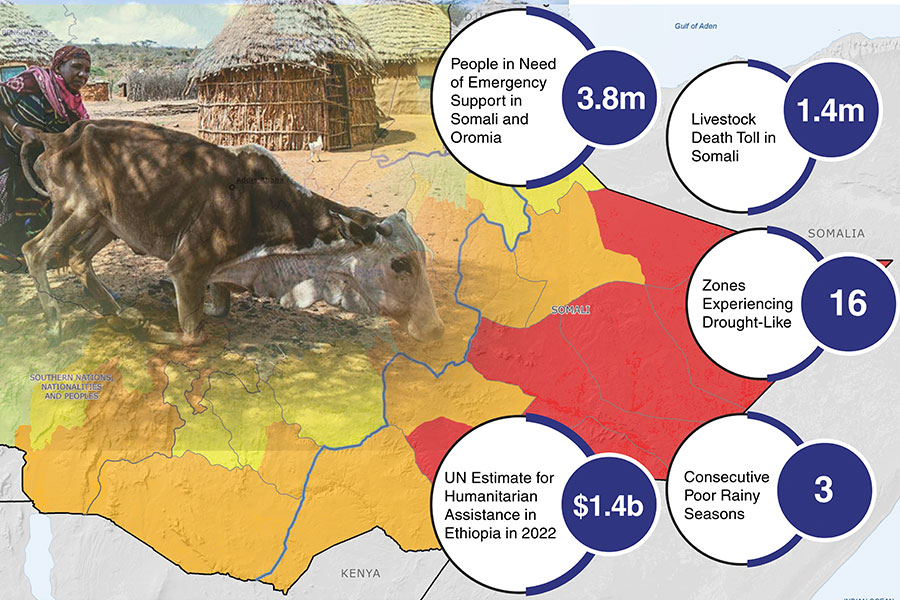
Early this month, Eshetu Lema, 48, was in Merkato, the largest open market in the capital. He was looking to buy teffin one of the specialized sections of the market, Ehil Berenda, where cereal crops are traded along with other agricultural commodities.
Eshetu, a construction worker and father of four, uses about 20Kg of teffeach month to feed his family, and he was carrying out his regular chore of buying the grain.
Teffis traditionally grown as a cereal crop. It is milled before it is fermented and then baked on large circular clay griddles to make a grey flatbread called injera. The cereal has been adopted by almost all Ethiopians as a staple food and is also used, albeit infrequently, to make porridge and traditional alcoholic brews like tela(beer) and katikala(liquor).
Eshetu used to spend around 400 Br to buy his monthly supply of teffbut was faced last month with something that he did not expect. He was confronted with having to pay 600 Br for the same quantity of grain he purchases monthly.
The price of a kilogram of teff, which had remained stable for around 20 Br a kilo for the last two years, has significantly increased in recent months.
“From time to time, the price of teffincreases, and it is difficult for me,” said Eshetu.
Eshetu claims that teffis his favourite food, not because he grew up consuming it, but because he has learned of its health benefits.
Ethiopia grows four types of teff: Liyu Magna(white teff), Melestegna,Abolseand Qey Teff (red teff).
Red teffis by far the cheapest and most popular variety consumed in the country, and it is considered to have higher iron content compared to the other varieties.
Different studies have shown that teff is a good source of fibres, iron, calcium and potassium; with high nutrition content, including 11pc protein, 80pc complex carbohydrates and 3pc fat.
Teffalso contains more lysine than barley, millet, wheat, rice and oats, according to EthnoMe, Harborview Medical Center’s ethnic medicine website.
Teff, one of the common grains for Ethiopians, is a good source of fiber, iron, calcium and potassium. It has a high nutrition content, including 11pc protein, 80pc complex carbohydrates and 3pc fat.
That is why Eshetu buys red tefffor his family.
Ashenafi Tolosa, a wholesaler of teffin his mid 40s and an 11-year veteran of Ehil Berenda, agrees with Eshetu on the rapid price escalation of teff.
Ashenafi gets his supply directly from farmers in Modjo and Gojjam, where he purchases about 20ql every week and sells four to ten quintals a day.
He claims that the level of price increase he has seen in the last two months is the first in his experience.
Ashenafi’s margin on each kilogram of teffis half a Birr, and he charges 24 Br per kilo for red teffand 29 Br for the white variety.
Bekele Alefata is another teffwholesaler with two decades of experience in the business who obtains his supply directly from farmers in Olonkomi, near Ambo, 60Km west of the capital.
“From my experience, it is unusual to see price increases of this size,” Bekele said. “Previously, I could turn around 50ql a week, but now I am lucky to get ten quintals a week from the farmers who supply me.”
Bekele also adds that the current teffshortage is mainly due to lack of rain during the Belg season, the short rain season that runs from February to May.
Significant areas of teffproduction in the country are in Oromia, Amhara, Tigray and SNNP regional states. In 2018, 6.7 million households were engaged in teffproduction, cultivating slightly more than three million hectares and producing 52.8 million quintals of teff.
Berhane Ayu, in her early thirties, is a new entrant in the teffbusiness and has been involved in the trade just two years. She obtains her supplies from wholesalers like Bekele, receiving five quintals of teffevery other week. She adds a premium of half a Birr for each kilo to her cost and retails it for 31 Birr for white teff, and 24 Birr for red teff.
“I am lucky if I sell two quintals a day now,” Birhan said. “I increased the price, because our suppliers have increased their prices. But the customers do not consider this,” she adds.
A teff grinding mill located in Kasanchis keeps the local populace fed.
Liyu Magna(white teff) is the most preferred type by consumers, commands the highest prices and only grows in some select areas of Ethiopia, mainly in the highlands where environmental conditions are more severe.
Among people living in areas of the country where the consumption of red teffis most prevalent, haemoglobin levels were found to be higher with a decrease in risk of anaemia related to parasitic infection.
In the current season, cereal crops were grown on 10.2 million hectares of land. Of this 3 million hectares were allocated for teff, and the total production in Meher, the main growing season, was about 50.2 million quintals.
Teffcovers 17.3pc of the total agriculturally productive land in Ethiopia, and the average productivity a hectare is 17.5ql.
To increase productivity, the Ministry of Agriculture is providing farmers with seeds and fertilisers, according to Danieal Dentamo, communication team leader at the Ministry of Agriculture.
According to Ethiopian agricultural standards, farmers have to use 100Kg of fertiliser per hectare, but they only use half of it, he said.
From time to time, the productivity of teffhas increased in the country, but the demand for teff is growing faster, which might account for the current increase in prices.
“To meet the target set by the second edition of Growth & Transformation Plan (GTP II), we’re planning to increase the productivity of teffto 23.14ql a hectare on average, from 17ql,” Danieal said.
The agricultural sector comprises 35pc of GDP (gross domestic product), and the Central Statistical Agency has planned for a total of 314 million quintals of agricultural products to be produced this season.
The Ethiopian Biodiversity Institute has catalogued 6,414 teff varieties among the nearly 72,874 pieces of genetic material it keeps of horticulture crop products in Ethiopia.
Jabi Tihenan Wereda in West Gojjam is famous for the production of teff, where 10,489ha of land is under cultivation with a production capacity of 22ql a hectare.
“Creating vibrant irrigation and drainage systems in which smallholder farmers have access to at least one water source can increase productivity,” said Aniley Liyu, agricultural development bureau coordinator at Jabi Tihenan Wereda.
“In our wereda, two teffvarieties, Quncho and Cross-37, are produced,” he said.
To increase the production of teff, the wereda focuses on these two varieties, which they supply to farmers as seeds along with fertilisers.
Agricultural extension plays a critical role in enhancing crop productivity by disseminating information and by improving farming practices and technologies of smallholder farmers, according to Sentayehu ShewaKena, an extension worker in West Gojjam Jabi Tihenan wereda, Arebayitu Kebele.
“We provide the necessary support to the farmers, but one of the main problems is that farmers are not willing to apply what we teach them,” said Sentayehu.
Also, it is hard to teach farmers to cultivate row cropping, according to him. In Arebayitu Kebele, the average cost of white teff is 1,944 Br a quintal.
To increase productivity, Zewdu Eshetu, associate professor at Addis Abeba University’s Paleo Environment programme, believes that farmers need more technical support than the fertilisers.
The Agriculture Ministry has to study the type of soil and which nutrients are missing in the soil, as well as what the plant needs to produce efficiently, according to Zewdu.
According to Zewdu, just applying fertilisers to the soil is an unnecessary cost best avoided by farmers. The extension workers should work actively on the site and with the farmers to create awareness and to determine the type and quantity of fertilisers that are needed for a particular plot of land and crop that grows on it.
The Ministry of Agriculture is also considering providing technologies that are cheap and require low power consumption that at the same time potentially improve productivity, said Zewdu.
He also claims that the price of the cereal has been increasing due to the intermediaries involved in the supply chain.
“Without these intermediaries being involved in the market chain, the price could not have risen as high as it has in recent months,” he said.
PUBLISHED ON
Jun 01,2019 [ VOL
20 , NO
996]

Featured |

Fortune News | Apr 10,2021

Fortune News | May 08,2022

Fortune News | Jan 29,2022

Radar | Jul 13,2024

Verbatim | Mar 11,2023

Fortune News | Mar 12,2020

Fortune News | Mar 02,2019

Radar | Jun 18,2022

Verbatim | Oct 05,2024

Dec 22 , 2024 . By TIZITA SHEWAFERAW
Charged with transforming colossal state-owned enterprises into modern and competitiv...

Aug 18 , 2024 . By AKSAH ITALO
Although predictable Yonas Zerihun's job in the ride-hailing service is not immune to...

Jul 28 , 2024 . By TIZITA SHEWAFERAW
Unhabitual, perhaps too many, Samuel Gebreyohannes, 38, used to occasionally enjoy a couple of beers at breakfast. However, he recently swit...

Jul 13 , 2024 . By AKSAH ITALO
Investors who rely on tractors, trucks, and field vehicles for commuting, transporting commodities, and f...

Jul 12 , 2025
Political leaders and their policy advisors often promise great leaps forward, yet th...

Jul 5 , 2025
Six years ago, Ethiopia was the darling of international liberal commentators. A year...

Jun 28 , 2025
Meseret Damtie, the assertive auditor general, has never been shy about naming names...

Jun 21 , 2025
A well-worn adage says, “Budget is not destiny, but it is direction.” Examining t...